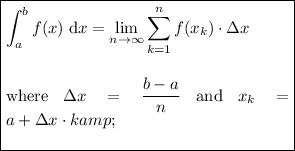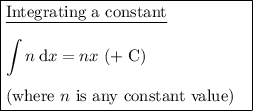Answer:
![\displaystyle \lim_(n \to \infty)\left[\sum^n_(k=1)\left\{-0.01\left(-10+(20k)/(n)\right)^2+40\right\} (20)/(n)\right]\; \sf square\;units](https://img.qammunity.org/2024/formulas/mathematics/college/991sm3v6bfmefmwzfzf9op9orz5auhith6.png)
![\displaystyle \lim_(n \to \infty)\left[\sum^n_(k=1)\left((780)/(n)+(80k)/(n^2)-(80k^2)/(n^3)\right)\right]\; \sf square\;units](https://img.qammunity.org/2024/formulas/mathematics/college/3uw41eib76f1m4oq6240jtsf4mb4n7jpl0.png)
793.33 square units
Explanation:
Use the Riemann sum to approximate the area under a curve using a series of rectangles.
A right Riemann sum uses rectangles where the curve of the function f(x) passes through the top-right vertices of the rectangles.
Definite Integral Notation (right Riemann Sum)
The area under the curve of f(x) on the interval [a, b] is represented by:

where:
- Δx is the width of each rectangle.
 is the height of each rectangle.
is the height of each rectangle.
 is the right endpoint of each rectangle.
is the right endpoint of each rectangle.- n is the number of rectangles.
The given interval is [-10, 10]. Therefore, a = -10 and b = 10:

As f(x) = -0.01x² + 40 then:

Substituting into the summation formula gives:

Expand the summation:





Therefore, the approximations of the area under the curve are:
![\displaystyle \lim_(n \to \infty)\left[\sum^n_(k=1)\left\{-0.01\left(-10+(20k)/(n)\right)^2+40\right\} (20)/(n)\right]\; \sf square\;units](https://img.qammunity.org/2024/formulas/mathematics/college/991sm3v6bfmefmwzfzf9op9orz5auhith6.png)
![\displaystyle \lim_(n \to \infty)\left[\sum^n_(k=1)\left((780)/(n)+(80k)/(n^2)-(80k^2)/(n^3)\right)\right]\; \sf square\;units](https://img.qammunity.org/2024/formulas/mathematics/college/3uw41eib76f1m4oq6240jtsf4mb4n7jpl0.png)

To find the exact area under the given curve, use the second part of the Fundamental Theorem of Calculus:
![\boxed{\begin{array}{l}\textsf{If}\;\displaystyle \int \text{f}(x)\;\text{d}x=\text{g}(x)+\text{C}\; \textsf{then:}\\\\\displaystyle \int^b_a \text{f}(x)\; \text{d}x=\left[\text{g}(x)\right]^b_a=\text{g}(b)-\text{g}(a)\\\\\textsf{where}\;a\;\textsf{is the lower limit and}\;b\;\textsf{is the upper limit.}\\\end{array}}](https://img.qammunity.org/2024/formulas/mathematics/college/65ekc0tt51n1z866fz65al96vcr5rtixad.png)
Therefore:

Evaluate the integral by using the following integral rules:


Therefore:
![\begin{aligned}\displaystyle \int^(10)_(-10) \left(-0.01x^2+40\right)\:\:\text{d}x&=\left[(-0.01x^(2+1))/(2+1)+40x\right]^(10)_(-10)\\\\&=\left[-(x^(3))/(300)+40x\right]^(10)_(-10)\\\\&=\left(-((10)^(3))/(300)+40(10)\right)-\left(-((-10)^(3))/(300)+40(-10)\right)\\\\&=\left(-(10)/(3)+400\right)-\left((10)/(3)-400\right)\\\\&=-(20)/(3)+800\\\\&=(2380)/(3)\\\\&=793.33\; \sf (2\;d.p.)\end{aligned}](https://img.qammunity.org/2024/formulas/mathematics/college/3svlghlwwo1nrkp9b7qso51vh49vfwdyid.png)
Therefore, the exact area under the given curve on the interval [-10, 10] is 793.33 square units (2 d.p.).